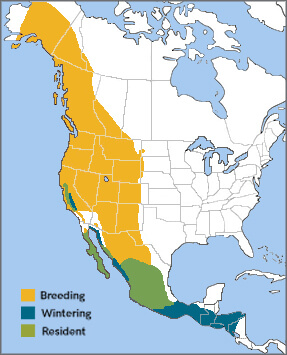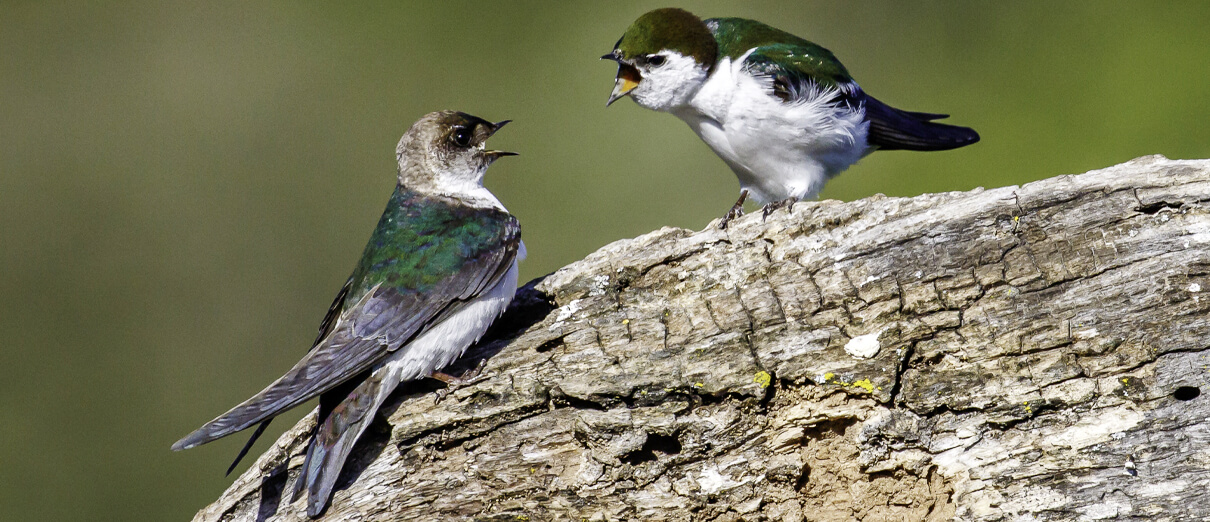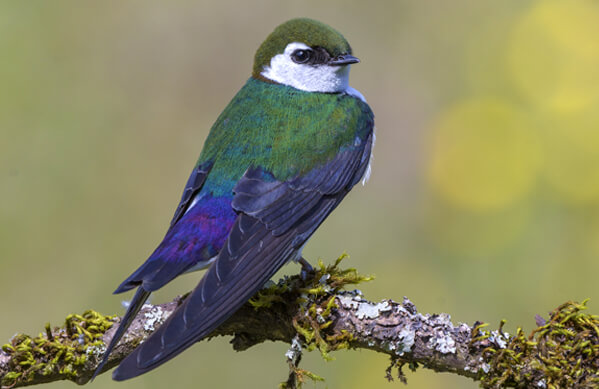
Violet-green Swallow range map by American Bird Conservancy
Prominent ornithologist John James Audubon described the colorful Violet-green Swallow as "the most beautiful of all the genus hitherto discovered." Like the closely related Tree Swallow, this acrobatic bird usually appears dark above and white below. But when caught in just the right light, the Violet-green Swallow dazzles observers with its iridescent green back and purple rump.
This species can also be identified by its white flank patches, or "saddlebags," easily seen as it zips through the air. Also, the white on its face extends part-way around its eye, giving this small swallow an innocent, elfin look.
Flying Under the Radar
Compared to other North American swallows, the Violet-green is poorly studied owing to its propensity to nest in remote, high-elevation sites such as cliffs and mountain forests. Much remains to be discovered about this bird's social and breeding behavior, diet, and annual survivorship.
Two subspecies of Violet-green Swallow are recognized, one migratory and one resident in northwestern Mexico. The migratory subspecies breeds west of the Rockies, from central Alaska and western Canada south to Mexican highlands. It migrates in large flocks to winter in Mexico, Guatemala, El Salvador, and Honduras.
In flight, the Violet-green Swallow gives a short, twittering chee-chee-chee, often heard at dawn or when it interacts with other swallows. Listen here:
(Audio: Matt Wistrand, XC336946. Accessible at www.xeno-canto.org/336946.)
High-flying Feeder
Like the Chimney Swift, the Violet-green Swallow is an aerial insectivore, catching and eating its prey on the wing. It feeds on a wide variety of flying insects, including flies, wasps, winged ants, bees, beetles, moths, and many others.
The Violet-green Swallow forages at higher altitudes than other swallow species, although it will also descend to feed low over ponds, particularly in bad weather. It usually forages in flocks, sometimes in association with other swallows or swifts.
Getting Cavities
Violet-green Swallows are secondary cavity nesters, meaning that they use tree holes excavated by another bird or animal, or previously occupied nests. This strategy is employed by a wide range of other birds such as the Red-crowned Parrot and Mountain Bluebird.
Violet-green Swallows also nest within crevices on large cliff faces and will sometimes choose niches and cavities on buildings as well. Like the Purple Martin, this swallow readily accepts artificial nest boxes. Although pairs typically breed independently, small colonies of up to 25 nests can be found at cliff sites.
Within the chosen cavity, the female builds a nest of grass, twigs, and rootlets. She lines it with feathers she and her mate have gathered. The male continues to bring feathers while the female broods her clutch of four to six eggs. Both parents feed the hatchlings, which leave the nest in a little under a month. Parents will continue to feed the young birds for a while after they fledge.

Violet-green Swallow female feeding young. Photo by Bob Gunderson
Withering Weather
The Violet-green Swallow is fairly common throughout its range but is affected by the loss of natural nest cavities due to deforestation, plus competition for remaining nesting sites, which are often dominated by the House Sparrow and European Starling, two introduced species.
Like other aerial insectivores, including swallows, swifts, the Common Nighthawk, and the Olive-sided Flycatcher, the Violet-green Swallow faces threats from widespread pesticide use, including the neonicotinoid insecticides, which decimate insect prey on breeding and wintering grounds.
Hundreds of Violet-green Swallows were among the victims of a massive migratory bird die-off in New Mexico in 2020. Experts think that this mass mortality was caused by a sudden cold snap, exacerbated by earlier fires and drought caused or worsened by climate change.
ABC is leading efforts to reverse declines in bird populations. Find out how you can help.
Donate to support ABC's conservation mission!



















































